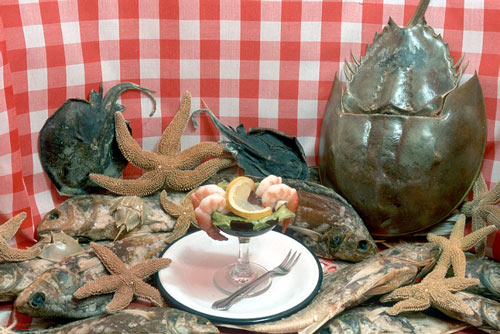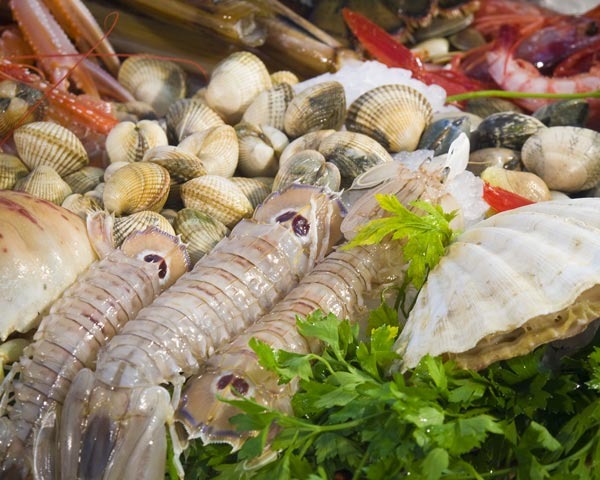What Fish Should You Be Eating Now For Flavor, Health, And The Environment?
We're always hearing that we should be eating more fish. Whether it's from our doctor, from a friend in the culinary industry, or from some extreme pescetarian who hates on the consumption of meat because of its effects on the environment, we're constantly being told that fish is a better cooking, and dining, option.
It's true, too. The health benefits of eating fish are undeniable, whether it's battling diseases or getting a huge dose of nutrients like protein, calcium, or vitamin B12. And when bought fresh and cooked right, fish is delicious, and it's a great choice for cooking because most kinds have a mild enough taste to pair them with any type of foods or flavors. Last but not least, even meat eaters can admit that the production of beef in this country does not lend itself to a good outlook for the environment, so why not order salmon over steak one night?
So now that we've covered why eating more fish is good for your taste buds, your body, and the planet, you might be asking yourself: Why should I being eating fish now?
Believe it or not, the consumption of fish is impacting our environment, too, and the more we make smart choices about what fish to eat at a given time, the more we'll be helping our planet survive.
"People don't think about seafood and how it effects our environment," explains Sheila Bowman, manager of culinary and strategic operations at Monterey Bay Aquarium's Seafood Watch Program.
How do fish have an impact on the environment? Like beef, fish make an impact in several ways, as Bowman explained to The Daily Meal, and there are a lot of different ways to think about making sustainable choices when consuming fish.
The first problem to consider is how we're destroying entire ecosystems within our oceans' waters. An example is with net fishing, most commonly used with  shrimp, which delivers multiple blows to our oceans' habitats. The nets are large and invasive; destroying ecosystems that don't deserve to be destroyed and collecting more than we need, an issue she defines as a "bycatch." Nothing is more evocative of this bycatch issue than a shrimp cocktail display the program has used to demonstrate what else is being pulled in when we go shrimping (photo right). There's also the practice of fishing in breeding grounds, because as Bowman explains it, "When these fishermen head out every day, they want to get the job done quickly and efficiently," and oftentimes that means disrupting large masses of fish in places where they gather to mate, making it harder for them to reproduce and thrive.(Photo courtesy of Monterey Bay Aquarium/Randy Wilder).
shrimp, which delivers multiple blows to our oceans' habitats. The nets are large and invasive; destroying ecosystems that don't deserve to be destroyed and collecting more than we need, an issue she defines as a "bycatch." Nothing is more evocative of this bycatch issue than a shrimp cocktail display the program has used to demonstrate what else is being pulled in when we go shrimping (photo right). There's also the practice of fishing in breeding grounds, because as Bowman explains it, "When these fishermen head out every day, they want to get the job done quickly and efficiently," and oftentimes that means disrupting large masses of fish in places where they gather to mate, making it harder for them to reproduce and thrive.(Photo courtesy of Monterey Bay Aquarium/Randy Wilder).
Along these lines, and one of our biggest problems, according to Bowman, are our less-than-conservative measures of fishing that are causing us to deplete entire populations of fish. "We take 50 million tons of fish when we should be taking 20," says Bowman. Along these lines, we have a tendency to eat fish that are higher up on the food chain, which are slow-growing, long-living species. Fish like swordfish, shark, and tuna are the "tigers of the aquatic world," she says, and by overfishing them, we're making them go extinct. Another way of putting it is thinking of cod as the elephants of the ocean, and less favorable fish but better choices, like sardines, as the chicken. Cod used to be a 6-foot-long, 240-pound fish, and they're now reduced to measuring 2 feet long and weighing less than 100 pounds.
Our fish farming practices are an issue as well, and one that most closely relates to the problems with cattle production. When fish are farmed in small, overcrowded tanks, they excrete large amount of toxins into the water and air, and are therefore harming the environment as well as each other, forcing these fish farming corporations to feed them drugs and antibiotics, which further affects their carbon dioxide omission, as well as our health.
As you can see, our choices about what fish to eat are not ones that should be just based on taste or preference, but ones that consider our Earth, as well. Bowman and her colleagues are looking to change people's understanding of fish and how to consume it, which is evident in the program's mission statement, which states that it aims to help "consumers and businesses make choices for healthy oceans."
As years pass and the tides change, Bowman and her team of scientists at the aquarium study government reports and journal articles, as well as communicate with fishery and fish farm experts, to develop a highly researched report that is then reviewed by a panel of experts from academia, government, and the seafood industry. The reports are updated every six months, which points to the important fact that what fish we should be eating for flavor, health, and the environment, depends on the current situation.
With these reports, the program not only hopes to raise awareness about the issues surrounding sustainable seafood, but make recommendations based off them that will help them succeed in their mission statement.
The program's recommendations are put into a buyer's guide, which is divided into three categories, with green, yellow, and red, and representing "best choices," "good alternatives," and ones you should "avoid," respectively. Since 1999, the program has distributed these recommendations through more than 40 million pocket guides and through their smartphone application, which has been downloaded nearly 1 million times.
While you may think that these recommendations will require you to ban swordfish or cod from your diet, not all hope is lost, says Bowman, because "any fish you want to eat, there's a sustainable option out there." Being a smart fish consumer means making informed, educated choices, says Bowman, about where the fish are coming from and how they are caught or raised. Is swordfish on the menu tonight? The program's guide will tell you to choose types that are harpoon- and handline-caught from Canada, the U.S., the North Atlantic, and the Eastern Pacific, and to avoid the imported, landline options. The best and easiest part is, all of this information is required to be made available to us by our fishmongers and grocery stores, and all we have to do is think to ask.
With the help of the program, we're ready to start making smart choices about the fish we eat, but we're not just going to stop there. Whether our top priority is health, flavor, or the environment, we want to make sure the choices we're making are sound with all three criteria. Which is why we've asked notable figures within the industry, including chefs Laurent Tourondel and Michael Ferraro, as well as influential people like chef Ray Dawson, director of culinary arts of the International Culinary Center, about what fish they're cooking these days. While their selections may not always be the most environmentally sound, with the help of the program's recommendations we're able to listen to both sides of the story and enjoy the fish in a safe way.
And while we already know that fish is good for us, we dug a little deeper and asked health professionals to explain even more why that's so. Dr. Tasneem Bhatia, author of What Doctors Eat and founder and medical director of the Atlanta Center for Holistic and Integrative Medicine, shares some of her healthiest picks of fish for us to choose from. We also share insight from Dr. Barry Sears, creator of the Zone Diet, on which fish are healthiest.
What you eat should always be an informed decision, based on what tastes good, what's going to make us feel good, and what's good for the environment. Here are 10 fish for you to be eating now that have been hand-selected with these things in mind.
Anne Dolce is the Cook editor at The Daily Meal. Follow her on Twitter @anniecdolce
